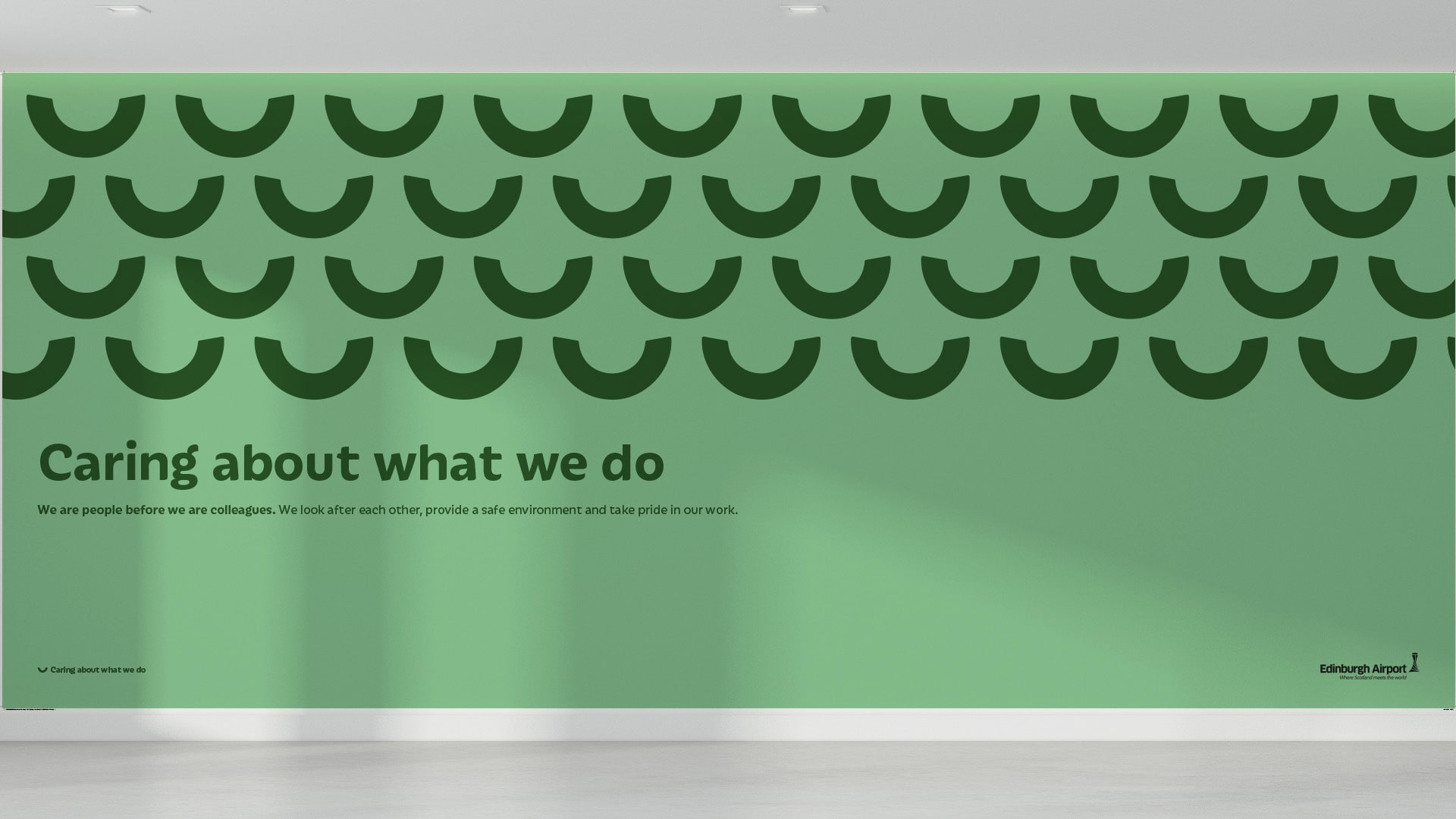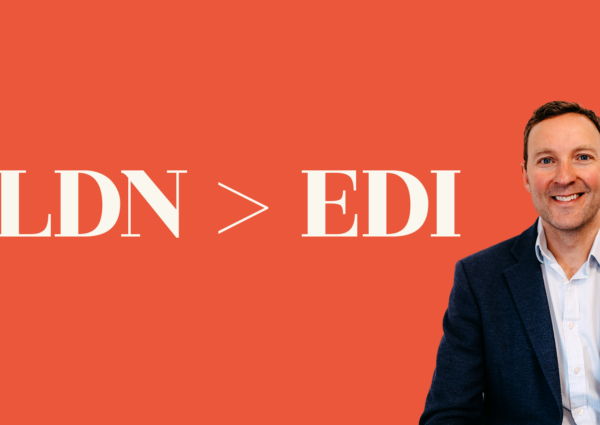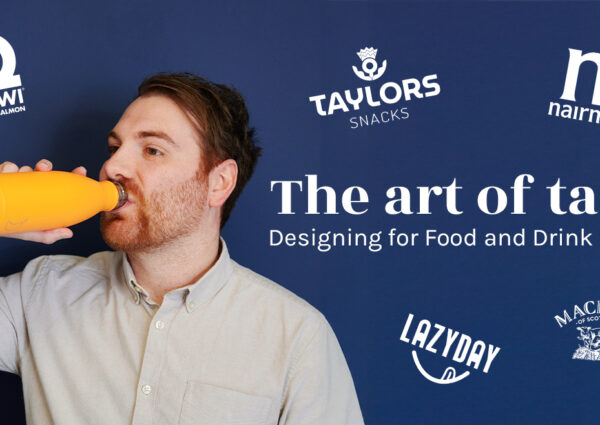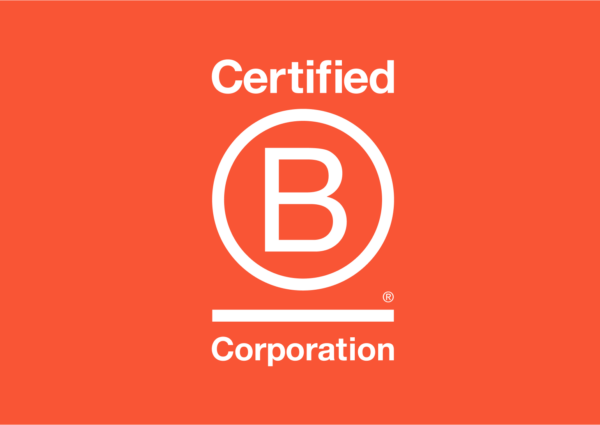Brand Wheel: the Definitive Guide
Sallie Bale • 15th Feb 2023
The brand wheel is a strategic tool for unlocking the power of brand identity. This is a step-by-step guide to developing, using, and measuring the effectiveness of a brand wheel.
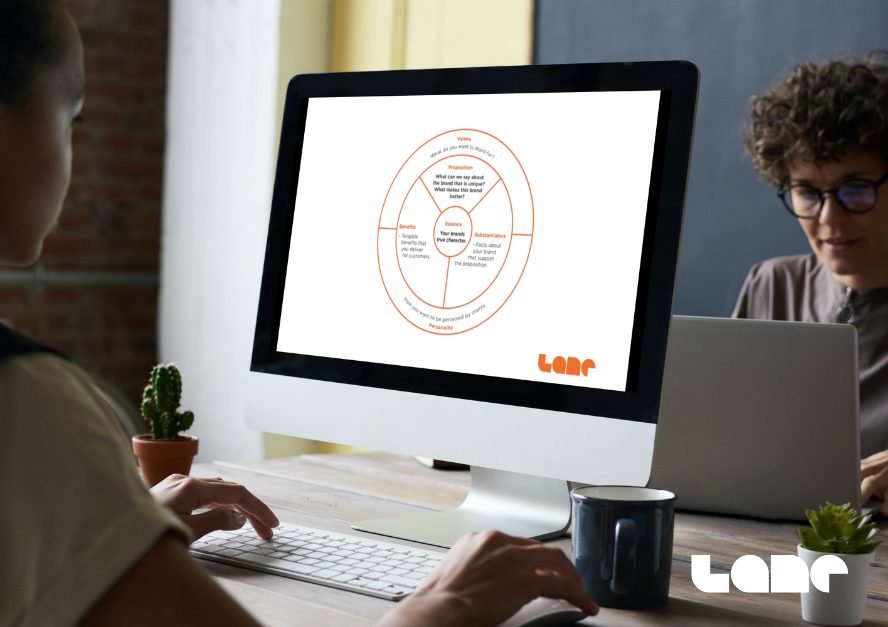
Contents
Here’s what you’ll find in our guide to using a brand wheel, to help you navigate through the sections:
- What is a Brand Wheel?
- Putting Emotion at the Heart of the Brand
- Brand Personality & Values
- Reasons to Believe
- Developing the Brand Proposition
- The Essence of the Brand Wheel
- The When and Why of Using a Brand Wheel
- How to Populate a Brand Wheel
- Where to Start When Creating a Brand Wheel
- Examples of Brand Wheels
- How do I Use a Brand Wheel?
- Measuring Brand
What is a Brand Wheel?
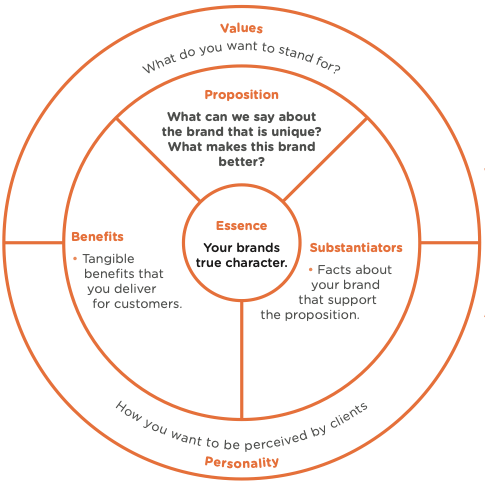
A brand wheel is a brand strategy model used to create a strong, consistent brand. It has the Brand Essence is at the epicentre, and shows that all brand elements are encompassed by the Values and Personality.
This circular model includes:
- Personality traits
- Brand values
- Proposition
- Brand essence
- Benefits
- Substantiators
Similarly, It is often also known as a brand essence wheel, a brand strategy wheel or a branding wheel. All these terms can be used interchangeably.
When and How Do I Use a Brand Wheel?
Designers, copywriters, and marketers use the brand wheel (or branding wheel) as an effective tool to create a holistic view of a brand’s strategy. It is a visual representation of the core elements that make up a brand. It outlines how they interact with one another to create a cohesive identity.
The key elements of a brand positioning wheel include Personality traits, Values, Proposition, Brand Essence and Reasons to Believe. Each element has its own unique significance, which when combined, create a comprehensive and powerful brand.
There are many brand strategy and positioning models out there. We believe the brand wheel diagram is concise and easy to use. It’s a great visual reminder of the key brand elements. Likewise, other brand positioning diagrams include the brand house, the brand key, the brand pyramid, and many more.
These are translated into the brand’s distinctive brand assets, such as the logo and colour palette, tone of voice and strapline, and carried through into campaigns.
Putting Emotion at the Heart of the Brand Strategy
We like to think that we’re absolutely rational beings. That we make decisions based on logic and reasoning. We think that’s how we shop. But it’s not. We’re instinctual, habitual and emotional.
As humans, we mostly shop on autopilot. How else could we walk into a supermarket containing 60,000 products and come out in half an hour with a few choice items?
Daniel Kahneman developed the idea of your system 1 brain (fast, automatic, routine, familiar tasks, initiative) and system 2 brain (slow, effortful, required for harder problems, logical, analytical).
The IPA dataBANK contains 1400 case studies of successful advertising campaigns submitted for the IPA Effectiveness Award competition over the last three decades. A study of the effectiveness of these case studies found that campaigns with purely emotional content performed about twice as well with only rational content. As you’ll see, those that were purely emotional did a little better than those that mixed emotional and rational content.
Defining and communicating the personality and values of a brand helps to build that emotional connection with a potential buyer, helping them to instinctively reach for your product as they walk past it down the supermarket (or even digital) aisle.
Brand Personality & Values
Just like all of us, brands have personality traits and value. And these help guide our unconscious, system 1 brain to make an emotional connection, that all important instinctual decision.
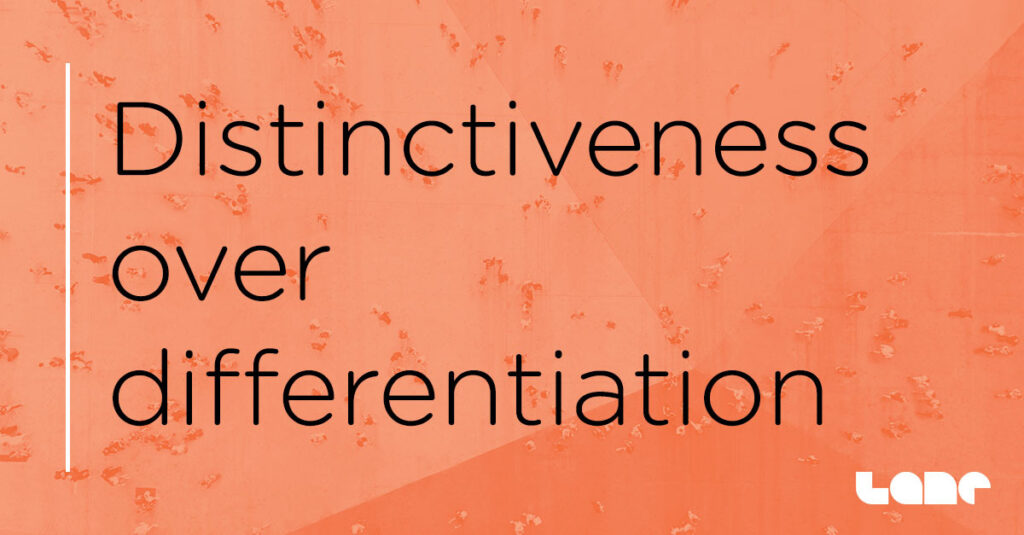
Traditional wisdom drives brands to differentiate, to be unique. However, modern brand thinking drives us towards being distinctive over differentiated. What we’re looking for is to stand out, grab attention and be absolutely clear about what the brand is.
An example of this is Kellogg’s enlarging their logo on their cereal, and making it consistent across all products.
Personality
How do you want your brand to be perceived?

Personality allows us to create a memorable and recognisable brand, with distinctive brand assets that belong unmistakably to the brand.
A great brand personality is all about being consistent, relevant and genuine. Make it meaningful, impactful, and emotionally connecting. It’s a reflection of the brand’s core values, beliefs, and purpose (want to learn more about purpose? read out guide to developing a brand purpose statement). When done right, this will shine through in every customer interaction.
Examples of words you might use for your brand personality could be: Upbeat, Spirited, Daring, Entertaining, Self-assured, Introspective, Assertive, Insightful.
When you’re looking at your brand’s personality, you want consider the ‘duh’ factor. For example, many brands want to to seen as Friendly. Well, duh. There are very few brands that would want to come across as unfriendly. Maybe the odd rebel, punk brand.
What do you really mean by friendly? Are you supportive? Do you go above and beyond to serve others? Are you super caring and considerate? Are you generous?
Perhaps you mean you’re outgoing and extroverted. Or playful or affectionate. Welcoming and inclusive or eager to please.
As you’ll notice, any of those are much more interesting, differentiated and above all much more meaningful than being a friendly brand.
Most importantly, we’re not looking to make something up. We’re looking to draw out the true nature of the brand, in order to communicate it clearly and consistently to make it easy to recognise and remember.
Brand personality trait examples
Here are some more personality traits to whet your appetite:
- Dramatic
- Witty
- Imaginative
- Perceptive
- Artistic
- Mature
- Relentless
- Discerning
- Visionary
- Intellectual
- Fierce
- Philosophical
- Noble
- Soulful
- Enterprising
A note on Brand Archetypes
You may be here expecting to see Brand Archetypes feature in the brand wheel.
In the past, brand archetypes a useful tool for companies to create a differentiated brand identity and a recognisable brand message. Archetypes are based on the work of psychologist Carl Jung. Jung believed that all humans had a set of universal archetypes that influence our behaviour and decision making. By connecting a brand to one of these archetypes, companies can create a consistent, recognisable message that resonates with their target audience. Popular brand archetypes include the Hero, the Explorer, the Caregiver, the Creator, the Sage, and the Ruler.
In other words, we tend to find these a bit restricting. We may give our brand a core or overarching brand personality, for example the Visionary Leader or the Skilful Scout. But we make sure each company’s brand wheel reflects their unique personality and values, as well as its ambition and direction.
In fact, when it comes to brand archetypes marketing heavyweight Mark Ritson listed archetypes as number two on his Definitive Marketing BS Index in a Marketing Week column.
Values
What does your brand stand for?

Whilst personality traits are how you show up in the world, what you look like, say and how you say it, values are what you stand for. Your core values are your unique combination of principles. These values, the beliefs of what you stand for, shape behaviours and actions. You are all committed to them. You live by them.
Your North Star.
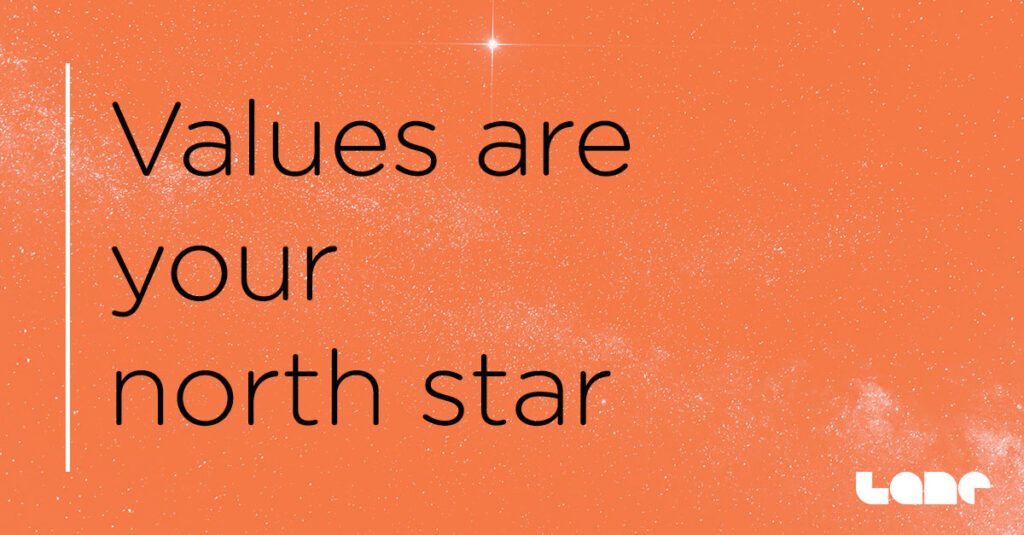
What should you look for when developing your brand values? Firstly, do they feel like true guiding principles? You want to be able to apply them to every part of the business, across all functions. They should be able to help shape behaviours and actions. It’s easy to confuse values and personality traits.
For example, you could describe Volvo as down-to-earth as a personality trait, and reliable as a core value.
Secondly, do they feel authentic? Can you see them currently demonstrated within the business? Don’t just chuck Sustainable in there because you feel like it should be in there. It’s fine for them to be ambitious and help support the future direction of the business. But not to be overly ambitious or unattainable.
Just like personality traits, the third thing to check is that that ‘duh’ factor. Is Integrity a guiding principle, or that just housekeeping? It might be a worthwhile value if your industry is tarred with a brush of not having Integrity, but you’ll have to work extra hard to prove that you’re the exception to that rule. Same with Honest, Expert, Respected, Quality, and so on.
Finally, are the specific enough? Back to Sustainable, what does that mean to your organisation? Is it about striving for Positive Change? Or maybe you want to focus on Always Being Best Practice. You could aim for being a Zero Waste company.
Brand value examples
- Creativity
- Adventure
- Selflessness
- Community
- Mastery
- Growth
- Equity
- Joyfulness
- Serenity
- Simplicity
- Restlessness
- Wellbeing
Reasons to Believe
Benefits + substantatiors = reasons to believe.

The RTBs create a brand identity that is memorable and powerful. They are the basis of brand stories and experiences. They are the ‘reasons to believe‘ the values, proposition and essence.
Just like an architect plans the layout, rooms and features of a house, a brand needs to plan its RTBs. The RTBs are the foundation of the brand and what the consumer will come to understand and trust. Make them strong and credible, built on evidence and research.
Brand benefits and substantiators create the RTBs.
Benefits are a statement of what the product does, how it does it, or how it makes consumers feel. Substantiation is the evidence to back up the benefit. This could be claims, facts, figures or research. When both brand benefits and substantiators are communicated together, it creates the RTBs by providing a powerful message for the consumer to believe in. Benefits act as a promise, while substantiation offers proof, trust and credibility.
Consumers may be aware of the brand and understand the promise, however they need to be convinced that the promise is credible and true. Consequently, combining benefits and substantiators allows the brand to strengthen the RTB by providing tangible and viable evidence. RTBs are the reasons why consumers will believe in the brand, use it now and in the future, and recommend it to others.
Developing the Brand Proposition
What can we say about your brand that is compelling and distinctive?

The proposition and essence of a brand work hand in glove. The proposition is what is distinct and differentiating about a brand. The essence is the expression of that in a few short words.
On the other hand, the brand proposition is slightly different from a Customer Value Proposition, which often uses the construction:
- For (target audience)
- Who (customer need or problem)
- We offer (product or service description)
- That (benefit to customer)
- Because (why you’re different)
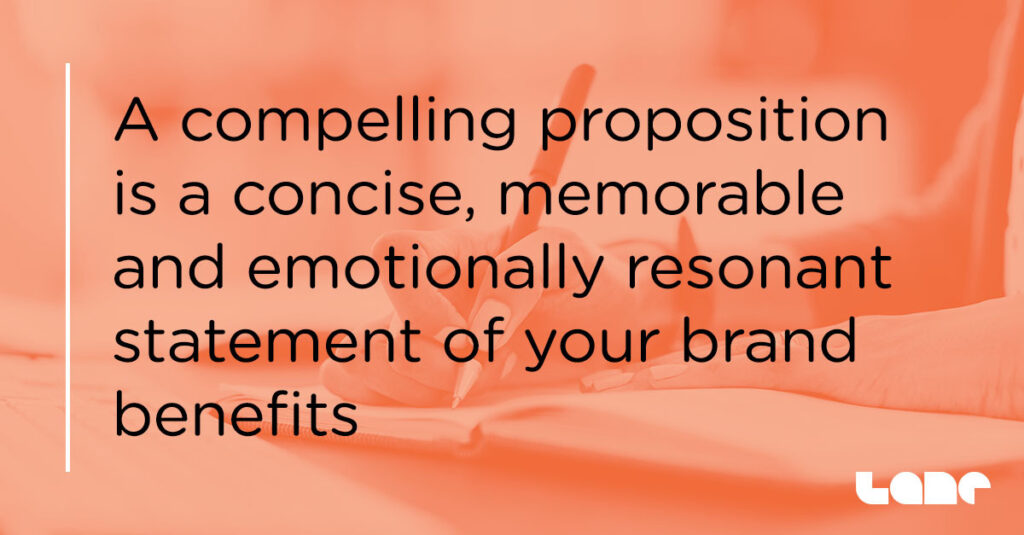
A brand proposition, meanwhile, focuses on what makes it different and distinctive. What do we have that sets us apart from the crowd, in a way that’s aligned with the personality and values of the company?
Subsequently the reasons to believe are core to this exercise. If done right, the idea behind the proposition should make itself apparent. So, what we’re looking for in a good proposition is a clear articulation of the brand benefits; a concise, memorable and emotionally resonant statement; that can be consistently recognised and repeated by key stakeholders.
The Essence of the Brand Wheel
Your brand’s true character.

A brand’s essence is like a signature dish – memorable and recognisable.
Often used internally for the marketing team to keep the brand consistent, these will also be the core of any external facing comms and messaging. The essence may even become a strapline, or be adapted to be the strapline.
Consequently, what we’re looking for in a good brand essence is that it’s a distillation of the proposition in a few short words. We’re looking for it to be engaging, compelling and creative. It should have a fluency about it.
What are the four elements of a brand essence statement?
You want to make sure your brand essence is:
- Authentic
- Distinctive
- Emotive
- Motivating
Why Use a Brand Wheel?
A brand wheel is an essential tool for any marketers looking to develop a strong brand identity. It can help them to engage with their audience. To stand out from the competition. Ultimately, it can help get more people to buy the product more often.
The brand wheel is particularly useful when launching a new product or entering a new market. On the other hand, it can be a useful exercise when a brand has stagnated. Perhaps it isn’t resonating with the target audience any longer. Or there’s a new audience that the brand wants to build.
In other words branding wheel provides a holistic view of the brand and allows designers, copywriters, and other marketers to make sure that their message is consistent across all channels.
How to Populate a Brand Wheel
Populating a brand wheel is a creative process that requires a lot of thought and consideration. It’s important to think about each element of the wheel and how it contributes to the overall brand identity.
The first step is to determine the values and personality traits of the brand. Choose these carefully and keep consistent throughout the wheel. Next, the proposition: make this concise and clearly explain what the brand stands for.
The Brand Essence is the essence of the brand and should reflect the values and personality traits of the brand. It should be something that resonates with the target audience and captures the essence of the brand. Finally, Reasons to Believe are determined. These are the reasons the target audience believes in the brand so articulate them as clearly as possible.
In short, you want to make sure the elements within your brand wheel are:
- Authentic to your brand
- Reflective of how you want it to be perceived
- Emotive and compelling to your target audience
- Distinctive
Where to Start When Creating a Brand Wheel
With many things, the hardest step is getting started. With a brand wheel it might be daunting to go through this process on your own. I love our tried and tested brand development process, which kicks off with a brand strategy workshop.
Download your Brand Wheel Recipe Box
All the raw ingredients you need to get started on your full flavour brand wheel, such as a project time plan, a blank brand wheel, a brand wheel with descriptions, and our brand wheel checklist.
Brand workshop
Our branding wheel process starts with a brand workshop. We come together with a cross-section of the organisation to draw out the true nature of the brand. It’s helpful to have different perspectives. It prevents myopic views from management, or marketing or other parts of the business. Having someone in a customer facing role can bring really useful insight.
The workshop takes participants through a number of brand wheel exercises.
We start with the core values and personality traits of the brand. Our process takes people through a number of exercises. These help us think about the elements in different ways. We want to balance the authentic nature of the brand, and the organisation’s aspirations.
We’ve developed a number of exercises that help us to extract the personality a brand through our brand workshop. Our workshops include a cross-section of people from within the business to help get a thin slice of the brand.
Recently, we translated our tried and tested brand workshop process into a brilliant workshop platform, with our friends over at Jointly. This means we can host workshops in person, remotely and hybrid sessions also work really well too.
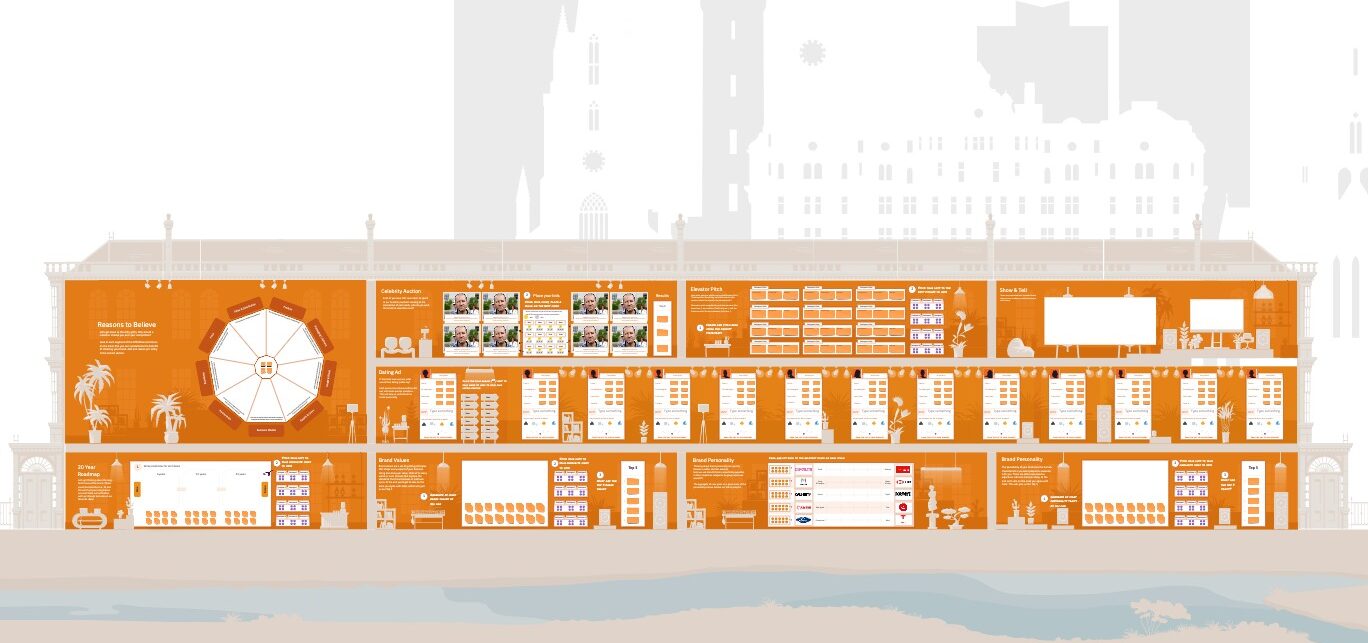
Here we dig into the personality of a brand with exercises such as the Celebrity Auction, the Dating Game, Brand Sliders (from the Google design sprint) and Notes & Votes (a more traditional Post-it Notes type exercise).
This session also covers the Reasons to Believe, which asks participants to think about all the different parts of the business, and why people choose you over a competitor.
We use this platform for all the exercises in our brand workshop. We also have campaign planning workshops and website planning workshops in this tool as well.
Bringing the branding wheel together
After the workshop, we work on the proposition of the brand. This should be concise and clearly explain what the brand stands for. The Brand Essence is a very short distillation of proposition. It also reflects the values and personality traits of the brand.
Creating a brand wheel is a creative process that requires a lot of thought and consideration. It’s important to think about each element of the wheel and how it contributes to the overall brand identity. With careful thought and consideration, a brand wheel can be an effective tool for any designer, copywriter, or marketer looking to create a powerful and cohesive brand identity.
It often helps to have an outside perspective to guide and challenge you throughout the process. It’s all too easy for organisations to get hooked up on something that is only important within their own business, or is politically important the business, or simply believe their own hype. Having an outside voice to breakdown some of these assumptions can lead to a much more robust and effective brand.
Examples of Brand Wheels
To get a better understanding of how a brand wheel works, it’s useful to look at examples of successful brand wheels. For example, Apple’s brand identity wheel includes their core values of creativity, innovation, and simplicity.
Amazon’s brand strategy wheel includes their core values of customer-centricity and convenience. Nike’s brand wheel includes their core values of performance, innovation, and inspiration.
How Do I Use a Brand Wheel?
Once you’ve developed your brand wheel, and are happy that the elements it encapsulates are reflective of how you want the brand to be perceived, in line with the ambitions of the brand, and compelling to your audience, it’s time to put all that good work into use.
The first thing to do is to reflect on whether your brand identify helps or hinders the communication of the elements in your brand wheel. If in your hart of hearts, you know that your logo, the colours, the tone of voice you currently use are doing you a disservice in communicating your brand wheel, it might be time for a change.
What is a brand essence wheel used for?
Every single thing that comes out of your marketing department should be referenced against your brand wheel. It should sit at the heart of your brand guidelines. As a matter of due diligence your team should know it back to front.
What we don’t want to do is spend all this time, energy and company funds developing the perfect brand wheel, for it to sit on a server or desktop somewhere, gathering digital dust.
So, print it out, stick it on your wall. Have it next to your computer in your home office. Create a credit card sized version to clip to your office pass. Whatever gets it into your field of vision daily.
Developing the brand identity
The next step you’ll take will probably be developing a new or adapted brand identity. You’ll want to work with a design team experienced in translating the heart of the brand wheel into its visual representation. This would include logo, colours, patterns, distinctive brand assets, illustration and photography, as well as copywriters who can develop your tone of voice, strapline and messaging suite.
Things to think about when developing a brand identity based on your brand wheel:
- Tone of voice will be very closely related to the personality traits
- The strapline may be the brand essence, or an external expression of it
- The role of the logo is to be distinctive, memorable and recognisable at a small scale. It is not there to communicate the element of the brand wheel
- The colour palette will draw inspiration from the elements of the brand wheel, and should help not hinder its communication, but again it will not be able to encapsulate every aspect
Measuring Brand
So, you’ve invested in developing a strong foundation for your brand, you’ve agreed on your brand wheel and have a distinctive and engaging new brand identity that reflects the DNA of the company and its ambitions.
How do you know if it was a success?
As Lane Media’s Managing Director Barry Fearn said at a recent Marketing Society Scotland event, remember to ABCD… always be collecting data.
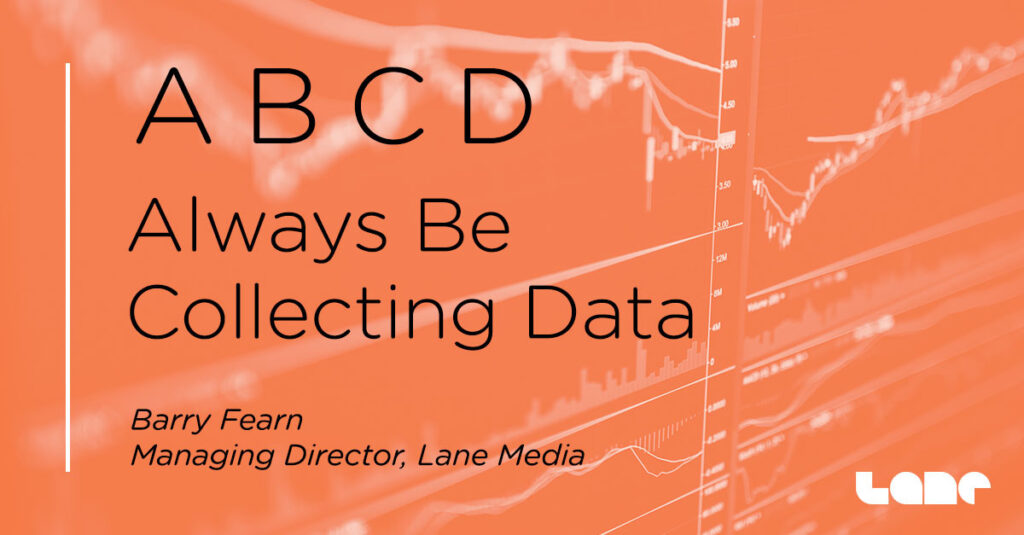
Brand positioning is a long term investment, and whilst we often see an immediate uptick in many short term KPIs (web traffic, sales, positive social engage, staff and customer feedback), its important to track brand health with consistency and long term goals in mind.
The overall health of a brand is a reflection of how successful and profitable it is and a predictor of its future profitability. Brand health tracking looks to benchmark aided and unaided brand awareness, propensity to buy, market share, brand sentiment, and brand associations.
Companies use brand health metrics to determine the effectiveness of their marketing strategies and to decide what changes need to be made to ensure the long-term success of the brand.
This is key to understanding not only the success of a brand wheel, and the brand identity and communications work that follows, but understanding the future performance of the business. Finding the right long term partner to develop and deliver this work is a crucial step in the process.
Download your Brand Wheel Recipe Box
All the raw ingredients you need to get started on your full flavour brand wheel, such as a project time plan, a blank brand wheel, a brand wheel with descriptions, and our brand wheel checklist.
Still not sure?
If you’re still not sure if a brand wheel is right for you, it might be because you have inkling that there are bigger issues with your brand, or you’re just not sure what the issues are. As a brand audit agency, we can help you answer some of those bigger questions, so you can understand what steps to take to make your brand more effective.
Or, read our guide to conducting your own brand audit.

Author Sallie Bale, Strategist, The Lane
With 15+ years experience Sallie is best known for getting to the heart of what is distinctive and motivating about a brand, and building connection with customers.
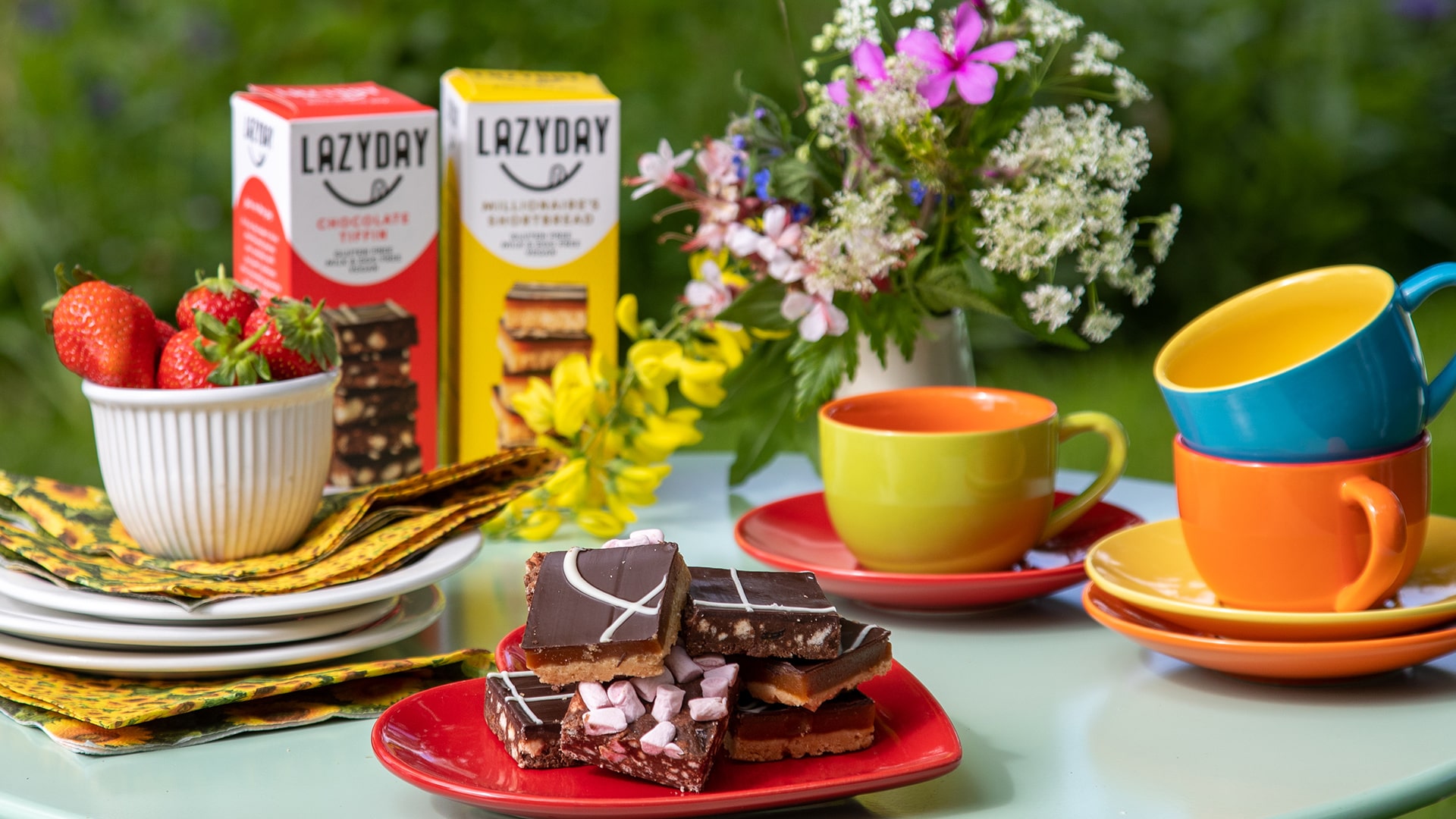
Bringing a smile to the supermarket aisle
View Case Study Bringing a smile to the supermarket aisle